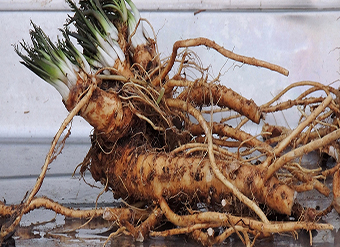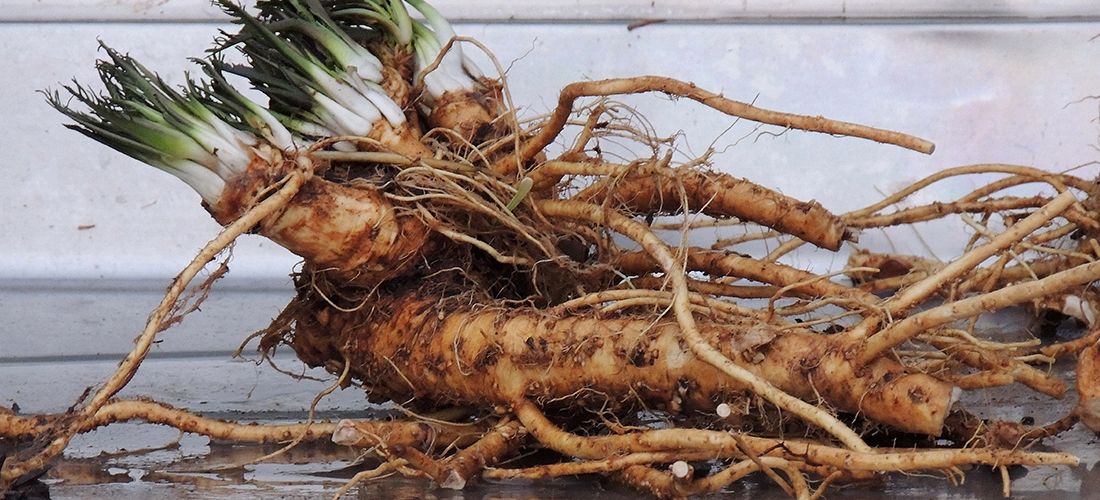
A Root that's Worth its Weight in Gold
- Roots
 It’s old, it’s bold and has been around for more than 2000 years.
It’s old, it’s bold and has been around for more than 2000 years.
It’s cured the privileged and commoners alike.
Its reputation of being fiery and untameable has tempted and tickled the palates of kings and ordinary people for centuries. Although, in England it was initially described as a sauce suitable only for country folk and robust labouring men as it was too strong for the tender and gentle stomachs of the landed gentry.
It’s a perennial herb with large bright green leaves with prominent veins and toothed edges, which rise directly from a thick white root and it’s propagated by root cuttings.
It’s an innocent looking root that has no aroma, until its pure white flesh is broken. Then it emits powerful volatile oils that pierce the sinus and make strong men cry.
Its medicinal qualities were so revered by the ancient Greeks that it was said to be worth it's weight in gold.
It’s still celebrated on the Seder plate during the Easter Passover and represents the bitter exodus of the Jewish people from Egypt.
Its origins are debated, but scholars have come to agree that it's well travelled and been traded since the Middles Ages. It migrated north to Scandinavia from southern Russia, south to central Europe, then to England and the Americas.
It was introduced to Australia in the 1800s by American miners working in the goldfields and we developed a taste for it. By 1935, the first Heinz product to be rolled out of their Australian factory in Victoria wasn’t baked beans in tomato sauce, it wasn’t tinned spaghetti and it wasn’t our beloved tomato sauce. It was horseradish sauce!
Horseradish, Armoracia rusticana, has survived the rise and fall of civilisations, pestilence, disease and religious persecution. For centuries it has been harvested in winter and preserved as horseradish sauce for year-round consumption. Regardless of where you get our horseradish from; the supermarket, gourmet deli, Sunday market or farm gate, its time to take fresh look at horseradish. Start today and be surprised how just a couple of teaspoons of good quality horseradish totally transforms mashed potato.
Fresh horseradish leaves, with their slight mustard flavour are the perfect addition to a salad. And, they can be handled in a carefree matter. But that’s definitely not the case with the root. Why does this humble herb get so angry that it wants to reduce us to tears when it is scraped or grated? When the flesh is broken, one of its enzymes (glucosinaloate) releases an explosion of volatile mustard oils. It’s mandatory to prepare the roots either outdoors or right next to the kitchen exhaust fan so that the mustard oil is drawn away from you and not over your eyes.

 Right here in South Australia, Brian Meakins, a grower and processor, has perfected a continuous harvesting and processing method which allows him to produce smaller daily harvested batches. With over 49 years of experience, Brian still loves his horseradish. He’s adamant it must be harvested and handled with care otherwise the roots discolour rapidly and turn grey.
Right here in South Australia, Brian Meakins, a grower and processor, has perfected a continuous harvesting and processing method which allows him to produce smaller daily harvested batches. With over 49 years of experience, Brian still loves his horseradish. He’s adamant it must be harvested and handled with care otherwise the roots discolour rapidly and turn grey.
For Brian, superior quality horseradish sauce must be “creamy, white, with no discolouration, have a fresh clean fiery flavour and pungent aroma that leaves the body and soul refreshed”. Brian markets his horseradish products under the Newmans label and currently supplies 95% of the Adelaide market through all the major supermarkets and speciality food stores and interstate. Recently expanding the business to include an epicurean farm gate experience at his farm and vineyard, Rusticana, locavores can now enjoy commanding views of 12 acres of deep rich green horseradish growing on the Bremer River flats at Langhorne Creek while sampling the latest horseradish and boutique wine releases.
Newmans horseradish has become a South Australian food icon and Brian is proud to be a second generation grower and the only horseradish grower and manufacturer in Australia.
